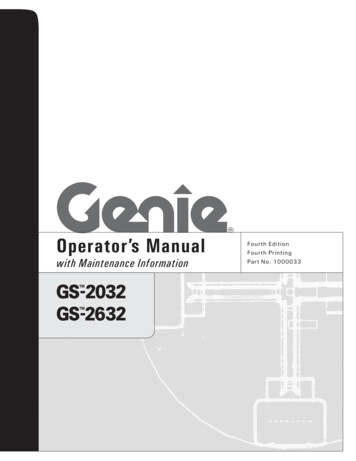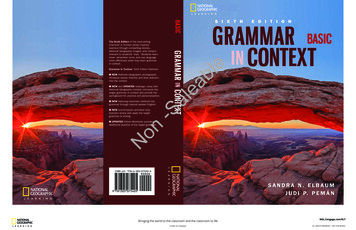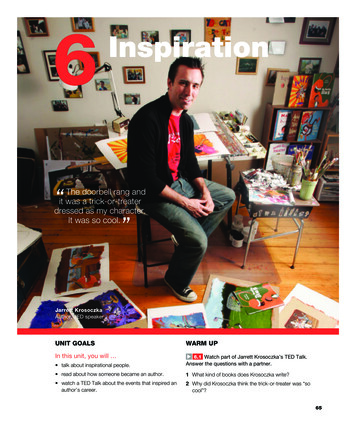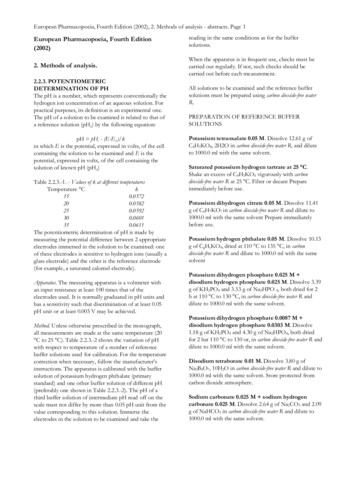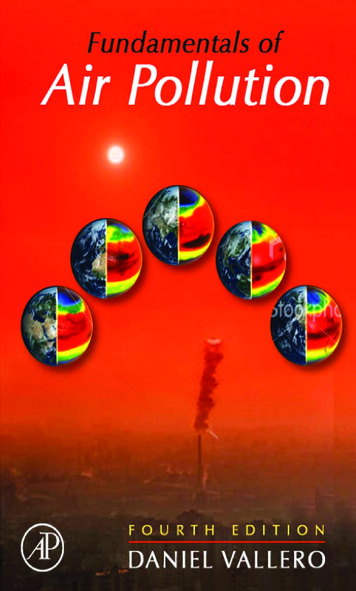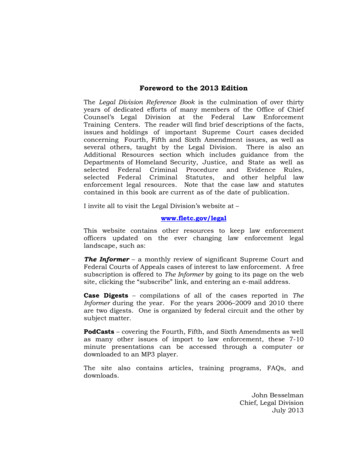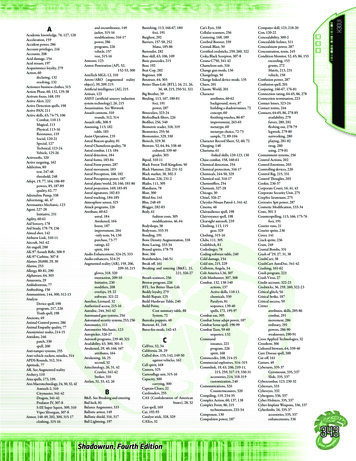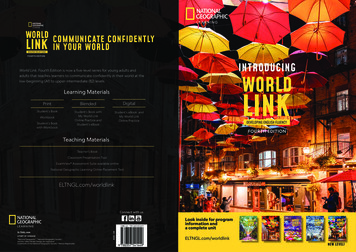
Transcription
COMMUNICATE CONFIDENTLYIN YOUR WORLDFOURTH EDITIONINTRODUCINGWorld Link, Fourth Edition is now a five-level series for young adults andadults that teaches learners to communicate confidently in their world at thelow-beginning (A1) to upper-intermediate (B2) levels.Learning MaterialsPrintBlendedDigitalStudent’s BookStudent’s Book withMy World LinkOnline Practice andStudent’s eBookStudent’s eBook andMy World LinkOnline PracticeWorkbookStudent’s Bookwith WorkbookFOURTH EDITIONTeaching MaterialsTeacher’s BookClassroom Presentation ToolExamView Assessment Suite available onlineNational Geographic Learning Online Placement TestELTNGL.com/worldlinkConnect with usELTNGL.comA PART OF CENGAGE2“National Geographic”, “National Geographic Society”and the Yellow Border Design are registeredtrademarks of the National Geographic Society Marcas RegistradasAUG / 2 0Look inside for programinformation anda complete unitELTNGL.com/worldlinkNEW LEVEL!3
COMMUNICATECONFIDENTLYIN YOUR WORLDThe teacher-testedlesson format nowcontinues to anew Level 4 thatteaches learnersto communicateconfidently at theupper-intermediate(B2) level.World Link, Fourth Edition teaches learners to communicateconfidently. It develops integrated language skills with anemphasis on spoken English through familiar topics, relevantgrammar, and essential vocabulary.World Link brings the world to the classroom through afamously fun video program that now features an optional‘Global Voices’ video section at the end of each unit.NEW TO THE FOURTH EDITION3MILESTONESA woman poses in her weddingdress in Havana, Cuba.LOOK AT THE PHOTO. ANSWER THEQUESTIONS.Relatable NationalGeographiccontent teacheslanguage in familiarand interestingsettings fromaround the world.1. A milestone is an important life event. Whatmilestone is pictured here?2. How do the people in the photo feel?3. What are some other important milestones?WARM-UP VIDEOWORD BANKretirement community a place whereolder people livestuck unable to move from a placeAWatch the first part of the video about Evelyn.Write the missing words.1. We used to have atake people to the grocery store.here to2. A lot of people werearound here.3. I said, “Joyce, I’ll get you to the grocerystore every.”4. I lost my driver’s license because somebodythought I was too.5. I went to6. And IBit.it.Read the quotes from Evelyn. Then watch therest of the video and answer the questions.What do the quotes mean? What do you thinkof Evelyn? How would you describe her?“I don’t have money to give, but I can givemyself, and my time.”“I don’t do this so you think I’m great.”CRetell the full story with a partner. Take turnsand use your own words.WL L3 U03 P5.indd 30-31GOALSLesson A/ Identify coming-of-age events/ Make predictions and discuss futureneeds and plansLesson B/ Explain generational trends/ Describe important milestones inyour life13/08/20 7:25 PMIn the new Global Voices videosection, learners watch real peoplemodel the key language andare then guided to practice andproduce the language.2 ‘Can Do’ Language Goalsencourage students tomindfully interact withtheir learning and producelanguage in real-worldscenarios. ‘Active English’ sectionsbring together the LanguageGoals of the lesson in a varietyof guided, communicativeactivities that teach learners toexpress themselves clearly. ‘Global Voices’ sections at theend of each unit allow studentsto demonstrate achievementof the Language Goals byfirst watching speakers modelthe language in a new videoprogram and then speakingthe language in therelated activities. ‘Real World Link’ sectionsafter every three units featureprojects that practice thelanguage in collaborative,relevant settings, helpinglearners to review andreinforce language lessons. A new Level 4 teaches learnersto communicate confidently atthe upper-intermediate(B2) level. Language instruction throughprint and digital that’s perfectfor all classrooms, includingonline learning.3
MAKE TEACHING AND LEARNINGEASIER ANDMORE ENGAGINGWITH WORLD LINKWorld Link provides language instruction in print and digitalthat’s perfect for all classrooms.STAY CONNECTED ANDDEVELOP TEACHING SKILLS.TEACHlively, engaging lessons that getstudents speaking.The Classroom Presentation Tool helpsteachers to present the Student’s Bookpages, play audio and video, and increaseparticipation through content andactivities that get students talking!A fun, optional video program meets avariety of teaching and learning needs:PLACEstudents simplyand reliably.Adaptive and mobile-friendly, theNational Geographic Learning OnlinePlacement Test places students into thecorrect level of World Link, aligns to theCEFR, and delivers a skill-specific diagnosticreport for each test taker. Increase meaningful communication inclass by giving students opportunities toconnect about something interesting, likestories from National Geographic explorersin the new “Global Voices” videos. Boost learner confidence by providingnatural models of spoken English. Entertain and engage learners in fun,familiar situations that present languagein the contexts where learners will use itmost frequently.LEARN AND TRACKwith My World Link Online Practice andStudent’s eBook. For students, the mobilefriendly platform optimizes learning andpractice through customized re-teachingand adaptive practice. For instructors,progress-tracking is made easy through theshared gradebook.ASSESSlearner performance andSign up for the National GeographicLearning Webinar Series to developvirtual teaching skills, participatein World Link-specific professionaldevelopment, and engage with avariety of other timely topics.ELTNGL.com/webinarsVisit National Geographic Learning’sIn Focus blog for a variety of 21stcentury instructional tips from expertsin English Language Teaching.ELTNGL.com/infocus/ ELTNGLprogress with the ExamView Assessment Suite.For formative and summativeassessment, teacherscreate and customize tests andquizzes easily using the ExamView Assessment Suite, available online.See page 6 for complete World Link videoprogram details.45
Intro Scope and SequenceWORLD LINK, FOURTH EDITION OFFERS AFUN, FLEXIBLEAND COMPLETEUnitVIDEO PROGRAM!ThemeVocabulary7ACTIVE ENGLISHAask out break up cheat on get along go out find out run into turn downA month later, Emma was single. When Jon (4.), he texted her again.This time, she agreed to (5.)with him. For months, they were happytogether. Then one day, while she was shopping, Emma (6.)Jon onthe street. He was with another girl. They were laughing and holding hands. Emmawas shocked. “Are you (7.)me?” she asked angrily. “Wait, Emma!” Jonsaid. But Emma walked away, and that night she (8.)with Jon. “We’redone,” she texted him.1. What do you think the message of this photo is?2. Give the photo a title. Then compare your titlewith the titles from the rest of the class.ABCa. Water from a tap1Introductions2Countries Countries and nationalities Describing cities Comparative adjectives Superlative adjectives3Possessions Graduation gifts Describing items Singular and plural count nouns This / That / These / ThoseF6. The firefighters want to inspire kids to follow their dreams and be happy.TFThink of the job you do or a job you’d like to do in the future.Answer the questions below.1. When did you know you wanted to do this job?d. Plastic toothbrushesBest friend: Ask questions and give your friend some advice.I’m really upset. I just broke up withJon. I saw him with another girl.2. We should ban single-use plasticsand make all plastic objectsreusable.3. We should keep using plastic. It’s areally useful material.Work in groups and compare your opinionsin B. Give reasons for your choices.DLesson B/ Discuss urban spaces/ Describe processesDI’ve seen himwith her, too.Compare your ideas with a partner.Explain your reasoning.I ran into Emmaearlier, and . . .WRITING Read how Jon and Emma are feeling now. What should they do? Turnto the Writing appendix and read one person’s email to Emma. Then write a shortmessage to Jon with some advice.Jon—Emma thinks I cheated on her . . . but I didn’t. I’ve texted her a hundred timesalready, trying to explain. I don’t want to break up, but she won’t reply to me. Whatshould I do: give up or keep trying?Now I can . . .Discuss dating experiences1. Yes, I can.Give relationship advice2. Mostly, yes.UNIT 4Lesson BWL L3 U04 P6.indd 58-59A new Global Voices videosection at the end of each unitallows students to demonstrateachievement of the LanguageGoals by first watching real peoplemodel the language in a new videoprogram and then speaking thelanguage in the related activities.available online: City Living is a lively sitcom thatmodels language functions inreal-life situations. Global Viewpoints are short,interview-style clips that provideexamples of spoken English fromaround the world.6 5913/08/20 7:26 PMAdditional, unit-related video Good Morning World is arelatable morning show seriesthat demonstrates grammar andvocabulary from the unitin context.Food Foods and drinks Tips for being a healthy eater Affirmative and negative statements Yes/No questions and short answers6Relationships Family members Relationships Possessive nouns Have got7Time Times and daily routines Weekend activities Prepositions of time: in, on, at, from, to Simple present Wh- questions8SpecialOccasions Months and holidays Festivals Prepositions of time: in and on When and How long questions9ComeTogether Chores and housework Dating Frequency adverbs Review: simple present Wh- questions10Home Using the phone Phone addiction Want to / have to Count and noncount nouns11Clothing Clothing Describing clothes Used to Comparisons with as 12Jobs Jobs Work goals Questions with like Talking about ability with can / can’tLacey England is partof a new generationof firefighters that isworking to bring morewomen into the job.3. Not yet.58 A Warm-Up Video at the start ofeach unit from authentic sourceslike National Geographic introducesthe unit topic, provides examplesof authentic spoken English,and features activities in theunit that guide learners inon-theme discussion.5Emma—Two weeks ago, I broke up with Jon because he cheated on me, but I stillhaven’t gotten over him. He keeps texting and saying, “Let’s meet.” I’ve turned himdown, but I miss him. What should I do?4B GOALSGOALSFT2. What made you want to do this job?What’s up, Jon? Things we do School subjects and majorsFFT5. The training program teaches women how to work like men.3. Do you think it helps people to seepeople like themselves doing importantor exciting jobs? Why or why not?Which opinion(s) do you agree with?ActivitiesFT4. Lacey thinks that it is important for people to see people like themselvesdoing the job they want to do.2. Work in pairs.1. We should ban plastic in alleveryday objects and usealternative materials.Lesson A/ Investigate and ask difficult questions/ Ask about everyday objectsCTT3. A man was surprised that Kelly was a fire chief.Jon and Emma: Sit with your best friend. Tell him or her what happened.f. Books about designC2. The women in the video are treated the same as the men they work with.1. Each person takes a role: Jon, Emma, Emma’s best friend, or Jon’s best friend.4 The present continuous tense:affirmative and negative The present continuous tense:extended timeWatch again. Choose T for true or F for false.1. Lacey wanted to be a firefighter when she was a kid.b. Toothbrushes around the worldg. Ancient teethThe Strawpocalypse isan art installation madefrom 168,000 plasticdrinking straws pickedup from the streets ofVietnam by people whoare committed to goingplastic straw-free.2. Why do you think mostly men have done this job? What is being done tobring more women in?B2. Why did they break up?Get into a group of four. Role-play the next step in Jon and Emma’s story.Watch the video. Discuss the questions with a partner.1. What job do the women do? What difficulties do they face?c. Chewing stickse. A bamboo toothbrushBATake turns reading the paragraphs in A aloud with a partner. Answer the questions.1. How did Jon and Emma meet and start dating?Watch the video and number the items in theorder you see them.GLOBAL VOICESJon and Emma met in a college biology class. They (1.) got along well andsometimes studied together. One day, Jon texted Emma and (2.)her, but Emma (3.)him. “Sorry, Jon, I can’t,”she said. “I have a boyfriend.”LOOK AT THE PHOTO. ANSWER THEQUESTIONS.WARM-UP VIDEOTry it out!Complete the story below using the correct form of the verbs in the box. Subject pronouns and possessiveadjectives with be Yes/No questions andshort answers with be Letters and numbers Personal information FavoritesAn optional video lesson starts and ends each unit:DESIGNTHINKINGGrammarFIVE VIDEO OPTIONS PER UNIT NEW! Global VoicesThe Warm-UpGood Morning WorldCity LivingGlobal Viewpoints7
Level 1 Scope and SequenceUnitThemeUnitTheme1People Personal information Physical descriptions Review of the simple present tense Describing appearance using be/have.1My Life People I know Education, school The simple present tense and presentcontinuous tense The simple past tense2Behavior A crowd scene Feelings Review of the present continuous tense Subject and object pronouns2Let’s Eat! How foods taste Eating healthy Comparative adjectives Superlative adjectivesShopping Foods in the kitchen Shopping Count and noncount nouns Quantifiers with affirmativeand negative statements3Mysteries Luck Solving mysteries Stative verbs Modals of present possibility(may, might, could, can’t)34Vacation Weather Preparing for a trip Connecting ideas with but, or, and so Possessive adjectives; possessivepronouns; belong to4Trends Describing trends,large numbers Fashion Quantity expressions Giving advice with could, should,ought to, and had better5Heroes The simple past tense with be The simple past: affirmativeand negative statements5MyNeighborhood Doing chores andrunning errands Getting around town Requests with modal verbs Subject relative clauses with that The simple past: affirmative and negativestatements (irregular verbs) The simple past tense: question forms6Goals Applying to college Life after graduation Plans and decisions withbe going to and will Predictions with be going to and willCelebrations Parties Festivals and events Agreeing with other people’s statements:so, too, neither, and either Time clauses with before, after, when The past continuous tense:statements / questions Adverbs of manner People changing their world KindnessGrammarVocabularyGrammar6The Mind Can you remember Sleep and well-being7City Life Places in a neighborhood What’s your city like? Prepositions of place Questions and answers withHow much / How many78All About You Sports and activities Personality traits Verb infinitive; verb noun How often ? frequency expressions8Tell Me a Story Describing stories Modern fairy tales9Change Life changes After graduation Like to / would like to The future with be going to9Work Work-related traits Describing jobs Asking for permission Verb infinitive vs. verb gerund10Health Our bodies I’m stressed Imperatives When clauses10Telephoning Using the phone Phone addiction Imperatives When clauses11Achievement Abilities Risk-takers Using can for ability Connecting ideas withbecause and so11Technology Describing new products Technology that helpssolve problems Used to Comparisons with as At the Movies Types of movies Review a movie! The present continuousas future -ed / -ing adjectives12Travel Tasks before a trip Air travel Modal verbs of necessity(must, have to, have got to) Present perfect (indefinite time) vs. simple past128VocabularyLevel 2 Scope and Sequence9
Level 3 Scope and ammarCommunity People Quantities Contrast defining and non-definingrelative clauses Notional Agreement: Subject /Verb AgreementThe WorkingWeek Work-life Personal qualities Dynamic and stative verbs Get / have / need someone / something3Creativity Verb-noun collocations Creativity Modals for suggestions,opinion, and advice Ability in the past4The SecondSelf Being online Catfishing Wish / If only (present and past) Past unreal conditionals It be adjective infinitive /Gerund be adjective Present and future time clauses withbefore, after, when, as soon as / once5Brainpower Memory Learning Past habits: used to / would Verb -ing or infinitiveBusiness andMarketing Business and commerce Marketing and advertising The passive voice: simple present andsimple past Connecting ideas with so, because, andalthough / even though6Storytelling Drama Descriptive synonyms Adverbs of manner, comment,place, time, and focus Narrative tensesWellbeing Injuries, illnesses, andtreatment Physical and mental health Expressions with get Reported speech: commandsand requests7DesignThinking Resource adjectives with-able suffix Neighborhoods The passive 1 (tenses and modals) The passive 2 (reporting, infinitive, -ing) Free time activities Preparing and embarkingon a trip Present perfect continuousvs. present perfect Present perfect continuous vs. presentPerfect vs. simple past8Science Factand Fiction Science words Cause vocabulary Future forms with will Connectors: reason, result and purposeSociety Urban issues Social issues too and enough Future real conditionals (type 1)9Body Matters Things we do Onomatopoeic words Comparative forms(with adjectives and adverbs) Modifying comparative forms10Money Saving and spending Ways to use andspend money Wish statements Negative modals10Keep It Legal Types of crime and criminals Judgement Modal verbs for certainty and possibility Reported speech11Trust Honesty and right and wrong Truth and lies Present unreal conditionals Reported statements with say and tell11HungryConsumers Consumption related words Food idioms Negative and embedded questions Question tagsOur World The environment andendangered animals Buildings and construction Subject and object relative clauses The passive with various tenses12Points ofView Place descriptions For and against1Public andPrivate Home improvements Public and private life Stative passive voice Giving permissionand expressing prohibition12GettingInformation Personal communication Types of news Defining subject relative clauseswith who and that Review of the present perfect23Milestones Coming of age Life changes Review of future forms Object relative clauses withwhere, when, and why4Men andWomen Ways to improveand change appearance Dating Adverbs used with the present perfect Phrasal verbs5AcrossCultures Appropriateness and respectacross cultures Intercultural communication67891210ThemeLevel 4 Scope and SequenceWhat are youinto? Determiners Cleft sentences11
4VACATIONLOOK AT THE PHOTO. ANSWER THEQUESTIONS.1. Where are the people? How’s the weather?2. What is a popular place for vacation in yourcountry? Why is it popular?WARM-UP VIDEOAThe video shows friends on a road trip* in theUnited States. Circle the places you know.1The Grand Canyon (Arizona)Cathedral Rock (Arizona)Saguaro National Park (Arizona)Horseshoe Bend (Arizona)Santa Monica State Beach (California)White Sands National Park (New Mexico)Lone Rock Beach (Utah)BWatch the video. Then number the places in Ain the order the friends visit each one.CCircle T for true or F for false. Then watch thevideo again and check your answers.A small village in the desertof southwestern Peru is apopular place for tourists.D1. The friends start their road trip onLone Rock Beach.T F2. They eat banana pancakes forbreakfast on the beach.T F3. They draw pictures of rocks atHorseshoe Bend.T F4. The friends drive west after theyvisit Cathedral Rock.T F5. They travel east to White SandsNational Park.T FAnswer the questions with a partner.1. Do you like this road trip? Why or wh
quizzes easily using the ExamView Assessment Suite, available online. EASIER AND MORE ENGAGING 4 5. An optional video lesson starts and ends each unit: WORLD LINK, FOURTH EDITION OFFERS A FUN, FLEXIBLE AND COMPLETE VIDEO PROGRAM! ESGN TNNG W
